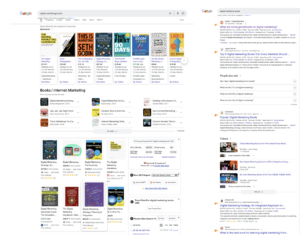Misunderstanding the intent behind a search is the quickest way to spending a boat load of cash and seeing very little in return, whether that cash was towards an SEO agency to optimise landing pages and provide content or directly into media spend, mastering the intent behind searches and understanding what motivates users to search the way they do is how you win across performance marketing channels.
#1 What Is User Intent?
You can’t master it, without knowing what it is, and you probably know what it is without knowing that you do. There are 4 main types of intent: Navigational (I want to go), Informational (I want to know), Commercial (I want to buy, but not just yet) and Transactional (I want to buy).
Navigational: the user is reasonably engaged and they want to go somewhere specific, such as a branded search or a login search – “reddit login”
Informational: the user is looking for information on a topic likely to educate – “What is Intent Marketing?”
Commercial: The user is in the market to buy, but potentially hasn’t decided exactly what that is yet – “Best Coffee Machine”
Transactional: The user wants to buy something and knows what it is – “Buy Nespresso Coffee Machine”
Pretty simple, right?
Well, yes and no.
#2 Why does understanding intent matter?
There are two types of intent, and search engines don’t make it easy & often don’t get it right. The lines have never been more blurred as the rise of tiktok & UGC, users’ searches have gotten lazier as they let the algorithm do the heavy lifting and ‘guess’ what they want or guess what their intent is with a particular search.
#3 User Intent
Understanding intent and what the user wants when they search a particular query means you can surface the right results by targeting the correct terms – If someone searches “buy nespresso coffee machine” they don’t want a guide on top 10 coffee machines, as they have already made their mind up, similarly if they search top 10 coffee machines, they don’t want a product page with a single product on it to purchase, as they’re still researching. By crafting your content and pages to service what the user wants, you can target them all the way down the funnel.
#4 Search Engine Intent (What the search engine thinks you want)
This is where it gets interesting, humans are creatures of habit and deciphering what they are looking for based on the words they use can be pretty straightforward in most cases, but search engines want to be smarter than that and users are also getting lazier than that, leaving this large grey area for misaligned intent.
Search engines (apparently) only want the best experience for their users, and part of that is giving them what they want, when they want it – so it’s in their best interest to service the websites & pages that answer what they THINK the user is looking for.
Let’s take an example where search engines ‘maybe’ get it wrong (but also maybe don’t)
The keyword Digital Marketing Books, this has no transactional element to it but also no informational element to it, it’s not “Buy digital marketing books”and it’s not “best digital marketing books” – What does the user want? Well each user could be different.
Well in this instance, even Google doesn’t know and can’t hazard a guess, so the SERP is littered with mixed intent – from shopping ads at the top, followed by a SERP feature showing an array of different books to Amazon ranking organically in P1 to reddit in P2 to Top 9 Digital Marketing Books That Every Marketer Should read in P3, it’s a total mess.

So as a marketer what do you do? Target Digital Marketing books on a category page, a product page or write a long-form guide about the best options? Do you risk any money in media spend?
Now, this is an extreme example of misaligned intent & how your own experiences and bias could quickly lead you down the garden path but the point stands, you need to know not only what users want actually what search engines think they want as well.
There will be instances where the above happens and seemingly search engines are still trying to adapt to what they think the user wants, and it will settle down at some point, that search above was solely a commercial search a month prior to those screenshots.
#5 User Intent Vs SERP Intent
Knowing what search engines want or at least what they think users want can only come from data & SERP analysis, a lot of tools (our favourites in-house are Ahrefs & SERanking) will show you what appears in the SERP & by that you can largely gauge what the SERP intent is.
If there are people also asks, featured snippets & an AI answer – this is largely likely to be either an informational SERP, a keyword asking a question & getting an answer.
If it’s shopping carousels & paid ads, this could lean more towards transactional, although this isn’t an absolute science it at least gives you an understanding of what Google is presenting in SERP.
Algorithms aren’t perfect, and we know that better than most in performance marketing so it’s always to be taken with a pinch of salt.
#6 Strategic Foundations
This may all seem pretty convoluted and tiresome, but understanding intent should be the crux of your performance marketing strategy, it spans both SEM channels and can be the difference between a happy client re-signing or an unhappy client sourcing a new agency partner.
Every strategy task should be routed in understanding the intent behind each keyword, your keyword research (which should ALWAYS be completed for any client, any channel) should contain an intent analysis, understanding search engines understanding of intent for particular keywords & categories, this informs the strategy moving forward, gone are the days of a straight forward commercial keyword research, it’s all one big happy keyword research task now.
Final Word
Understand ALL the terms in the market & then understand how to target them, whether that be by blog posts, commercial landing pages, product pages, long-form guides, interactive video – whatever it may be, this builds your entire content strategy.
Then
How best to acquire the traffic to these content forms, organic search, organic social, paid social, paid ads, shopping – whatever it may be, this builds your acquisition strategy.
Put the two together and you’ve got intent aligned content creation coupled with a multi-channel acquisition strategy driving users to the pages based on knowing exactly what they (and search engines) expect to see.
Not getting the return from your keywords?
Let’s have a chat about your keywords, and let’s see if you’re suffering from incorrect intent.








